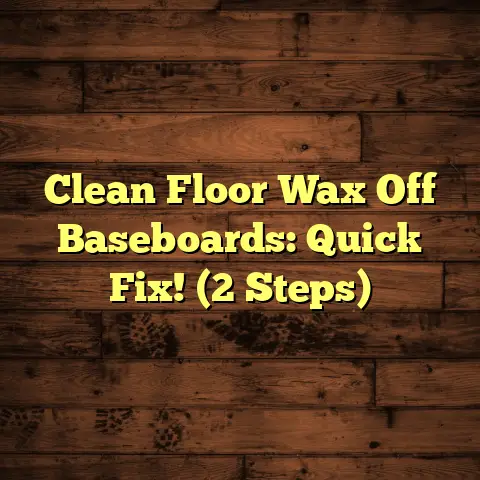30-Year Laminate Warranty Coverage? (2 Things to Know!)
Imagine this: You’ve just installed gorgeous new laminate flooring in your home. The colors pop, the patterns are perfect, and you feel a swell of pride every time you walk in the door.
You did your homework, picked a high-quality laminate with a 30-year warranty, and you’re feeling pretty smug about your wise investment.
Fast forward a few years. You start noticing scratches, some fading, maybe even a bit of buckling. Uh oh.
Now you’re wondering: “What exactly does my 30-year warranty cover? Am I really prepared for the unexpected flooring headaches?”
That’s what we’re diving into today!
As a flooring contractor, I’ve seen countless homeowners blindsided by the fine print.
This article will break down two critical things you absolutely need to know about that 30-year laminate warranty.
We’ll equip you with the knowledge to make smart decisions and protect your flooring investment. Let’s get started!
Section 1: Understanding the Scope of a 30-Year Laminate Warranty
1. Definition of Warranty Coverage
Okay, so you see “30-year warranty” and you think you’re golden, right? Not so fast.
Let’s talk about what that warranty actually covers. Typically, a 30-year laminate warranty includes protection against:
- Structural Defects: This means the core of the laminate failing, like delamination (layers separating).
- Surface Wear: Resistance to wear-through under normal residential use.
- Manufacturing Defects: Issues that arise from the factory, like faulty locking systems.
But here’s a crucial distinction:
- Limited Warranty: This is the most common type. It usually means that the warranty’s coverage decreases over time (pro-rated), or it only covers specific issues.
- Full Warranty: Rarer than a unicorn, but it means the manufacturer will repair or replace the flooring without cost to you during the warranty period.
Which one do you have? Dig out that paperwork!
2. Common Exclusions
This is where things get interesting (and often frustrating).
Warranties always have exclusions. These are the things they won’t cover. Here are some biggies:
- Water Damage: This is huge. Laminate and water are not friends. Spills need to be cleaned immediately. Flooding? Forget about it.
- Improper Installation: If you didn’t install the floor correctly, or you hired someone who messed it up, the warranty is void.
- Normal Wear and Tear: This is subjective, but think minor scratches from pets, fading from sunlight, or dents from dropping heavy objects.
- Commercial Use: Warranties are almost always for residential use only. If you install laminate in your business, you’re out of luck.
- Inadequate Maintenance: Using the wrong cleaning products or neglecting regular upkeep can also void the warranty.
The Fine Print is Your Friend!
Seriously, read it. I know it’s boring, but understanding the specific terms and conditions is essential.
What’s considered “normal wear and tear” according to their definition? What specific cleaning products are approved?
Knowing these details can save you a major headache down the road.
3. Manufacturer vs. Retailer Warranties
Who’s backing that warranty – the company that made the flooring (the manufacturer), or the store where you bought it (the retailer)?
There’s a difference.
- Manufacturer Warranties: These typically cover manufacturing defects and structural issues. They’re the more comprehensive of the two.
- Retailer Warranties: These might cover installation issues or offer additional protection, but they’re often limited in scope.
Sometimes, you’ll have both a manufacturer’s warranty and a retailer’s warranty. That’s great! But make sure you understand what each one covers.
What to Look For When Purchasing:
- Check the Warranty Paperwork: Ask to see the actual warranty document before you buy. Don’t just rely on what the salesperson tells you.
- Compare Warranties: Look at the coverage details, exclusions, and limitations of different brands.
- Consider the Retailer’s Reputation: Is the retailer known for standing behind their products? Do they have a good customer service track record?
Section 2: The Claims Process and Your Responsibilities
1. How to File a Warranty Claim
So, you’ve got a problem with your laminate, and you think it’s covered under warranty. Now what?
Here’s a step-by-step guide to filing a claim:
- Review the Warranty: Double-check the warranty document to make sure your issue is actually covered.
- Contact the Right Party: Is it a manufacturer or retailer warranty? Contact the appropriate party.
- Gather Documentation: You’ll need proof of purchase (receipt), photos of the damage, and possibly installation records.
- Prepare a Detailed Description: Write a clear and concise explanation of the problem. Include when you noticed it, how it happened (if you know), and any relevant details.
- Submit Your Claim: Follow the manufacturer’s or retailer’s instructions for submitting the claim. This might involve filling out a form online or sending a letter.
- Be Patient: Warranty claims can take time to process. Follow up regularly with the manufacturer or retailer to check on the status of your claim.
Tips for Gathering Evidence:
- Take Clear Photos: Use good lighting and take photos from different angles. Zoom in on the damage.
- Keep Records: Keep copies of all communication, receipts, and documents related to the claim.
- Get a Professional Opinion: If possible, have a certified flooring inspector assess the damage and provide a written report. This can strengthen your claim.
2. Responsibilities of the Homeowner
Your warranty isn’t a free pass to neglect your floor. You have responsibilities to uphold your end of the bargain.
Here’s what you need to do to maintain warranty validity:
- Proper Installation: This is huge. If the floor wasn’t installed correctly, the warranty is likely void. Hire a certified professional installer.
- Use Approved Cleaning Products: Check the warranty document for a list of approved cleaning products. Using the wrong products can damage the floor and void the warranty.
- Maintain Proper Humidity Levels: Extreme humidity can cause laminate to warp or buckle. Use a humidifier or dehumidifier to maintain consistent humidity levels.
- Protect Against Scratches: Use rugs in high-traffic areas, and put felt pads under furniture legs.
- Clean Spills Immediately: Don’t let spills sit on the floor. Wipe them up right away.
- Follow the Manufacturer’s Instructions: Read the manufacturer’s instructions for care and maintenance, and follow them carefully.
Regular Upkeep is Key
Think of your laminate floor like a car. You need to perform regular maintenance to keep it running smoothly.
Sweep or vacuum regularly to remove dirt and debris. Mop with an approved cleaner as needed. Address small issues before they become big problems.
3. Understanding Pro-rated vs. Non-Pro-rated Warranties
This is another critical distinction that can significantly impact your wallet.
- Pro-rated Warranty: This means that the amount of coverage decreases over time. For example, if your floor fails after 15 years (halfway through the 30-year warranty period), the manufacturer might only cover 50% of the replacement cost.
- Non-Pro-rated Warranty: This means that the manufacturer will cover the full cost of repair or replacement, regardless of how long you’ve had the floor.
Real-World Scenarios:
Let’s say you have a laminate floor with a 30-year warranty, and it costs $3,000 to install.
- Pro-rated Example: After 20 years, the floor fails due to a manufacturing defect. The warranty is pro-rated, and the manufacturer only covers 33% of the replacement cost (since 10 years of the warranty have expired). You’re stuck paying $2,000.
- Non-Pro-rated Example: After 20 years, the floor fails due to a manufacturing defect. The warranty is non-pro-rated, and the manufacturer covers the entire $3,000 replacement cost.
See the difference? A non-pro-rated warranty is obviously more valuable.
Conclusion: Reflecting on the Value of Warranty Coverage
Let’s recap what we’ve covered:
- Understand the Scope: Know what your warranty covers and, more importantly, what it doesn’t.
- Read the Fine Print: Don’t skip the small details. It’s where the exclusions and limitations hide.
- Fulfill Your Responsibilities: Proper installation and maintenance are crucial for maintaining warranty validity.
- Know the Difference Between Pro-rated and Non-Pro-rated: This can save you serious money down the road.
A 30-year laminate warranty can provide peace of mind, but it’s not a magic bullet.
By understanding the details of your warranty and taking proactive steps to protect your flooring, you can maximize your investment and enjoy your beautiful laminate floors for years to come.
Don’t just assume you’re covered. Take the time to educate yourself, ask questions, and make informed decisions. Your floors (and your wallet) will thank you!





